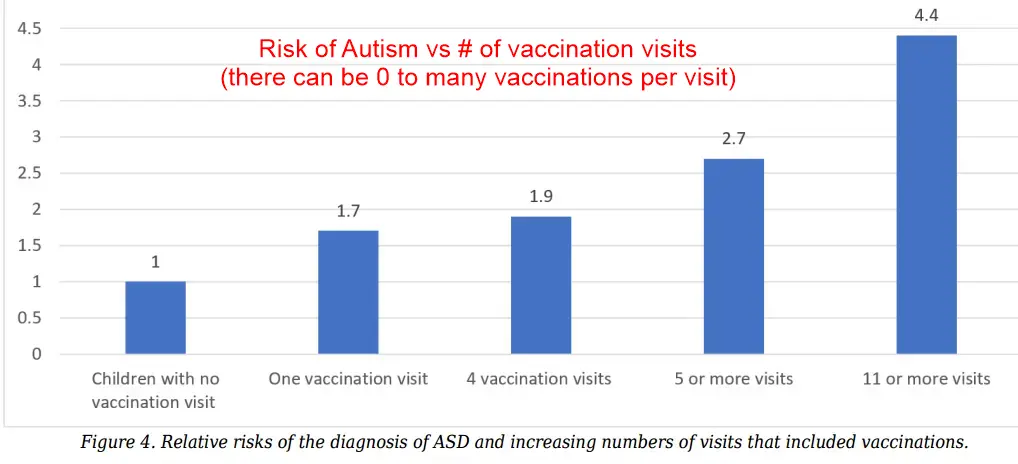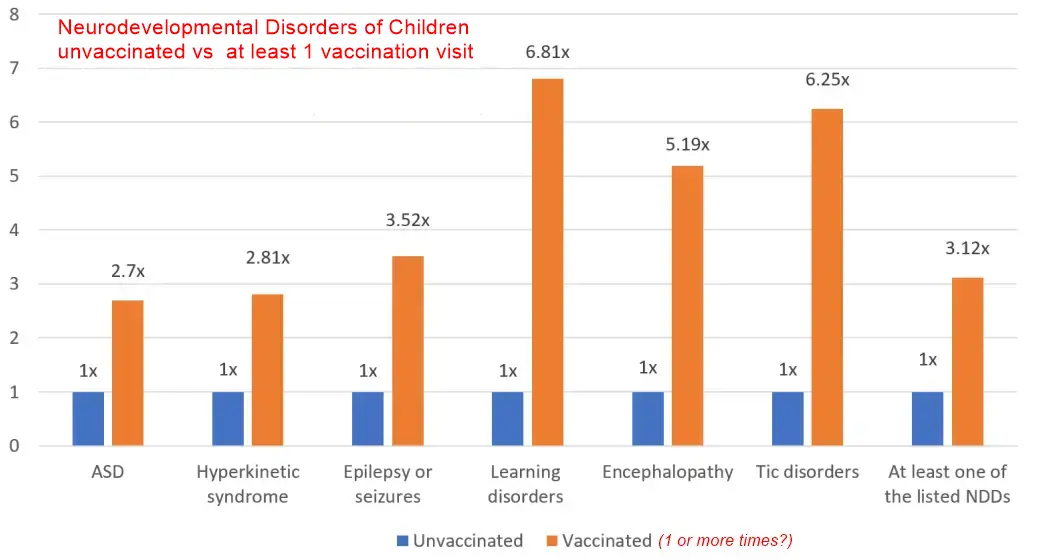Multiple Childhood Vaccinations increased autism risk by 4.4 X (Florida)
Vaccination and Neurodevelopmental Disorders: A Study of Nine-Year-Old Children Enrolled in Medicaid
Science, Public Health Policy, and the Law and Applied Knowledge Volume: v6.2019-2025
The journal is not indexed by Pubmed note the members of the board of directors
The journal is run by James Lyons-Weiler who is concerned about vaccines
Anthony R. Mawson1 amawson@chalfontresearch.org, Binu Jacob1
Dose dependant: more vaccination visits lead to an increased risk of Autism

89% of the Medicaid Children had 1 to 17 vaccinations (11% had no vaccinations)

Other Neurodevelopmental Disorders are even more associated with vaccination

Background: Vaccinations required for school attendance have increased nearly threefold since the 1950s, now targeting 17 infectious diseases. However, the impact of the expanded schedule on children's overall health remains uncertain. Preliminary studies comparing vaccinated and unvaccinated children have reported that the vaccinated are significantly more likely than the unvaccinated to be diagnosed with bacterial infections, allergies, and neurodevelopmental disorders (NDDs). The objective of this study was to determine the association between vaccination and NDDs in 9-year-old children enrolled in the Medicaid program. The specific aims were to test the hypothesis that:
1) vaccination is associated with autism spectrum disorder (ASD) and other NDDs;
2) preterm birth coupled with vaccination increases the odds of NDDs compared to preterm birth without vaccination; and
3) increasing numbers of vaccinations are associated with increased risks of ASD.
Methods: The study population comprised children born and continuously enrolled in the Florida State Medicaid program from birth to age 9. Vaccination uptake was measured by numbers of healthcare visits that included vaccination-related procedures and diagnoses. Cross-sectional analyses were performed to calculate prevalence odds ratios (Aims 1-2). A retrospective cohort design was used to compute relative risks specifically of ASD (Aim 3).
Results: The analysis of claims data for 47,155 nine-year-old children revealed that:
1) vaccination was associated with significantly increased odds for all measured NDDs;
2) among children born preterm and vaccinated, 39.9% were diagnosed with at least one NDD compared to 15.7% among those born preterm and unvaccinated (OR 3.58, 95% CI: 2.80, 4.57); and
3) the relative risk of ASD increased according to the number of visits that included vaccinations.
Children with just one vaccination visit were 1.7 times more likely to have been diagnosed with ASD than the unvaccinated (95% CI: 1.21, 2.35) whereas those with 11 or more visits were 4.4 times more likely to have been diagnosed with ASD than those with no visit for vaccination (95% CI: 2.85, 6.84).
Conclusions: These results suggest that the current vaccination schedule may be contributing to multiple forms of NDD; that vaccination coupled with preterm birth was strongly associated with increased odds of NDDs compared to preterm birth in the absence of vaccination; and increasing numbers of visits that included vaccinations were associated with increased risks of ASD.
📄 Download the PDF from VitaminDWiki
Other reports on this study
The study was reported on In Steve Kirsch's Substack
Honest AI reads the Mawson paper on autism and recommends the CDC warn all parents that it's more likely than not that vaccines cause nearly 80% of autism cases Kirsch Jan 31, 2025]
Vaccination and Neurodevelopmental Disorders (Brain Inflammation and Damage) Unbekoming
The Defender Jan 2025
By age 10, a child in Florida typically receives 17 vaccinations
4-5 doses of DTaP, 4-5 doses of IPV (Polio), 2 doses of MMR
3 doses of Hepatitis B, 2 doses of Varicella, Multiple doses of Hib and PCV
5+ possible explanations
The immune system is unable to recover from concurrent vaccinations (depleted Vitamin D)
Problems with an ingredient in some vaccines e.g. aluminum
Risk increases only if the vaccine gets into the bloodstream
Risk increases only if low Vitamin D
Risk only increases with vaccinations before - perhaps age 3
Other Autism Risk factors
Having an autistic sibling: 20X
2014 later proven to be greatly decreased if the mother took lots of vitamin D in a subsequent pregnancy
Autism 20X more likely if acetaminophen (Tylenol) from age 12 - 18 months - July 2023
16,000 results for query of acetaminophen and autism in Google Scholar July 2023
A Systematic Review of the Link Between Autism Spectrum Disorder and Acetaminophen: A Mystery to Resolve - 2022 📄 PDF
ADHD 2 X more likely if Tylenol used a lot during pregnancy (Autism increased too) – Dec 2016
Father over age 50: 2.2X
- A review of the risk factors for Autism - Oct 2024 - [https://doi.org/10.1093/eurpub/ckae144.1324FREE PDF]
Mother lived near a freeway during the third trimester of pregnancy: 2X
https://www.niehs.nih.gov/health/topics/conditions/autism
Less than 6 months between births 2.5X
Kaiser Probably Low vitamin D
22+ VitaminDWiki Infant-Child pages with VACCIN in title
This list is automatically updated
{LIST()}
Wonder how many conformation studies will be published in major journals within a few years?
The data has been available in 50 states and scores of hospital electronic record systems
The problem has been the risk of getting his license revoked if he published the data
